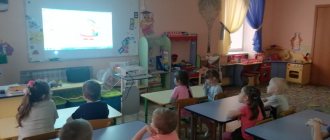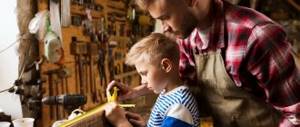In preschool childhood, children usually go through the first stage of developing a culture of etiquette. This is due to some features of personality development during this age period:
- Children have developed imaginative concrete thinking.
- They are very suggestible.
- They easily imitate adults.
- The teacher has unquestionable authority.
- They prefer to follow a pattern.
- The main activity of children is play.
According to this specificity, preschoolers can perceive and develop etiquette habits. However, this is only possible if they are connected with their lives, help them communicate and are illustrated with clear examples in the form of ideal patterns of behavior of people from their immediate environment. Due to the fact that an adult has high authority, etiquette requirements for a child become something natural and necessary. They readily follow them because they come from parents or teachers.
Development of etiquette ideas in children
Methods for selecting content and methods for developing etiquette concepts in preschoolers are described in detail in the studies of L.F. Ostrovskaya and I.N. Kurochkina. Many other researchers agree with these authors that it is possible to introduce preschoolers to a culture of etiquette at an early age, and this should be done as early as possible.
This is due to the way preschoolers develop ideas about how to interact and communicate with peers and adults. For example, today children are taught to behave correctly at the table. They are also taught to communicate kindly and respectfully with their peers. Of course, the content of education as you grow older should become more complex and rich. This will allow the preschooler to form a system of ideas about etiquette and teach him to behave correctly.
In his article, V.K. Kotyrlo writes about the characteristics of the development of knowledge about etiquette in preschoolers. They write that children in older preschool age are able to gain knowledge of how to properly participate in a conversation, how to behave while eating, what rules must be followed in public transport and other public places.
Step-by-step development of etiquette in children
After analyzing the characteristics of preschoolers, scientists proposed several stages in the development of knowledge about etiquette:
- The first stage: the child gets acquainted with the rule, corrects the knowledge that he already has.
- Second stage: the developmental environment is replenished with the necessary items that would allow the child to rehearse the application of the studied etiquette rule.
- The third stage: children consolidate their acquired knowledge in games and classes. To do this, you can also organize entire festive and entertainment events.
- Stage four: children independently follow etiquette rules when the need arises.
For the conversation to be effective, you need to choose the right illustrated material. This includes works of art, books, articles, filmstrips, videos and cartoons.
Today, a large variety of illustrated materials are produced for preschoolers. But it can be difficult for a teacher to find a suitable one, organize it by topic, and supplement the found sources with other information.
In addition to visual aids, you need to think about what pedagogical tools to use so that this material allows children to gain new knowledge about moral standards, relating them to their own lives, deeds and feelings.
For example, you can think of questions that would direct the discussion in the right direction. It is also necessary, with the help of questions, to teach preschoolers to analyze moral phenomena, compare them, synthesize and generalize.
Preparing an ethical conversation with children
Preparing for a conversation, preschoolers perform various tasks. The content of such tasks, their volume - all this depends on the chosen topic, on the specific moral phenomenon and on the developmental characteristics of the children themselves.
For example, when children take part in a conversation about working conscientiously, they receive assignments based on stars.
- The first star should find out if the children have any chores and how they feel about them.
- The second star must find suitable poems and stories about child labor and how to help adults.
- The third star should ask parents questions about their work, and ask them what work discipline is.
- The fourth star must find pictures depicting work activities.
- The fifth star collects sayings or proverbs about work.
This way all children are involved in preparing for the conversation. Of course, not everyone does it equally well. But everyone can bring their own contribution, which will allow everyone in the group to develop a positive attitude towards work.
File of conversations in the senior group
Among the verbal methods of interaction with children of the senior and middle groups (5–6 years old) of preschool educational institutions, conversation, as a form (question-answer) for discussing a certain topic, occupies a special place.
For your information! For preschoolers of this age group, conversation is a basic form of communication, which is designed to enrich the experience of life, develop curiosity and make a person more sociable.
Conversation with preschool children
In the work of a kindergarten teacher, an obligatory item is the compilation of card files of conversations of various topics and types. A conversation with older children, a thematic conversation helps to understand how to behave in a given situation, react correctly and not make a mistake. Cognitive, useful information will benefit not only educators, but also mothers.
Conversation about professions in the senior group
The teacher should try to form realistic ideas about a person’s everyday work life.
It is important to enrich the knowledge of preschoolers and their ideas about different professions (firefighter, space specialist, and so on). Thanks to classes and conversations in the group, the vocabulary is enriched and coherent speech is formed.
On a note! This type of conversation forms the ability to coherently and consistently convey a text read or heard according to a drawn-up plan. It has a positive effect on the development of attention and memory of preschool children, and develops logic.
Conversation “Rules of behavior in public places”
The conversation “Rules of Conduct in a Public Place” is required to be included in the file cabinet. The purpose of the conversation is to develop the students’ ability to behave in accordance with moral standards and etiquette rules developed and implemented by the children themselves in the process of working in a group on class topics.
Teacher talking to children
The teacher must convey information and discuss with children the rules of behavior in public places. This helps develop the communication skills of preschoolers.
Conversation about healthy lifestyle in the senior group
A conversation on healthy lifestyle in the preparatory group and a file cabinet with the goals of the Federal State Educational Standard are being developed. Necessary for consolidating the action plan when washing and knowledge about the purpose of hygiene items. The program should also develop in the child a desire to be clean and tidy, eat right and play sports.
For your information! A conversation about health teaches dialogue and kindness in communicating with each other and with adults.
Conversation about health in the senior group
The lesson includes two programs. The first is called “The skeleton is our support.” During the morning lesson, the teacher should introduce preschool children to the structure of the skeleton. Explain why it is needed for the human body, talk about the mechanisms of muscle tissue and its functionality.
It is important to expand students’ knowledge of how to strengthen muscle and bone tissue. Use illustrations as visual material, teach students to recognize and be able to talk about the human skeleton.
Healthy lifestyle for students
The teacher must arouse in pupils an interest in the body, a conscious attitude towards the body. For lessons, you should prepare a model of a human skeleton or a picture.
Second program: “Posture - slender back.” It is aimed at familiarizing children with the concept of “posture” and its importance for the body and human health. The teacher talks about posture problems and introduces children to knowledge of how to maintain correct posture. The teacher should teach children to recognize and be able to talk about the structure of the skeleton, correct and crooked posture from pictures.
For your information! It is important to interest the child so that he takes care of his health from an early age. For the lesson you will need pictures depicting a skeleton, a person with a curved spine, and with healthy posture.
Conversation about winter in the senior group
The purpose of the lesson is to systematize the understanding of pupils of the middle and senior groups of preschool educational institutions about winter phenomena in winter. It is important to learn to find connections between:
- the life of animals and birds (how they winter);
- states of nature;
- air temperature;
- state of water and land.
On a note! During the lesson, the teacher teaches how to see and give an aesthetic assessment of natural beauty in May or another season. Forms a poetic perception of nature. Every new year, the teacher takes a new month (January, February, and so on). Lessons about the seasons will help develop memory, thinking, imagination, and will also teach you to take care of the nature of your native land.
Step-by-step drawing for beginners - lessons for children
Conversation with migratory birds
When spring comes, the teacher of the senior group must draw up a work plan in accordance with the Federal State Educational Standard. Provide conditions for deepening students’ knowledge about:
- weather;
- thaw;
- plants;
- migratory birds.
Studying birds in preschool educational institutions
Thanks to this, preschool children will learn more about the work of people in spring, get acquainted with paintings by famous artists about spring, and make their own crafts from paper, plasticine, and natural materials. At the end of the week, the teacher conducts a “Why and Why” quiz. Asks questions and listens to children’s answers, thereby consolidating the students’ knowledge.
On a note! The teacher can not only talk with children, but also play. It is useful to organize a variety of relay races in a group and on the street. The teacher, involving pupils in outdoor activities, solves the problems of physical development.
Conversation about indoor plants in the senior group
The kindergarten teacher talks to the children in the group, tells them what kind of indoor plants there are, shows pictures or visual examples on the windows in the room. Teaches you to recognize and correctly name types of flowers.
In addition, he shows how to care for some types of plants (watering, lighting, pruning, fertilizing) and improves the students’ skills in caring for indoor plants. The child learns to be thrifty with plants. The materials you will need for this lesson are:
- Pictures of indoor plants.
- Maintenance equipment - skewers for loosening, watering cans, rags, aprons.
- Filmstrips, audio films.
The teacher is working with the children in a group where there are pots of flowers.
Organizing ethical conversations
It requires great skill from the teacher to competently conduct a conversation. It is necessary to help children be active during the conversation.
The methodology implies that children cannot only be given knowledge in a ready-made form. Education should be based on approaches that would allow the formation of active and conscious individuals. It would be right if, after the conversation, the teacher asks the children questions, clarifies and directs their statements, and corrects incorrect thinking.
It is necessary to keep in mind that children's thinking has certain characteristics. Sometimes guys can make a generalization based on just one fact. For example, if someone has not learned his lessons once, then he is bad. We need to teach children to provide reasons for their generalizations and to be more specific. For example, it’s bad - it could be lazy, absent-minded, or disobedient. Some terms may be completely unfamiliar to children.
And we need to introduce these words into children’s vocabulary, fully revealing their content. Sometimes it is difficult for preschoolers to indicate what the signs of a particular moral quality are. They tend to focus on unimportant things. It is impossible to consider each of the moral qualities separately, in isolation from each other. It is necessary to emphasize how they are interconnected.
Thus, preschoolers should see that it is easy to become arrogant if you focus on your strengths. If you are not humble and do not have a sense of duty, you can become vain and ambitious.
Sometimes a good quality can turn into a bad one. For example, politeness can become servility.
Morning conversation with children in the older group
Morning activities are part of the daily routine in kindergarten. In addition, conversations in the morning with the children in the middle group are part of the daily routine of each pupil.
Morning conversation at the preschool educational institution
Before starting mental work and work, as well as rest, it is important to talk with children on a pre-selected topic. This regime is considered to be well-structured, and therefore has serious pedagogical significance.
Spiritual and moral education of a preschooler through fairy tales
Daily morning activities:
- They teach children to a certain regime.
- They help provide the body with a change in activity, that is, they protect the central nervous system from overstrain.
- They help to form strong dynamic stereotypes of life.
In a word, conversation in the morning is an important moment in the life of every student. In the future, growing up, he will, as usual, unwind, relaxing in the morning while talking in the family, with relatives.
Experts recommend combining conversations with active games. It is necessary to attract the attention of children by any means. Any description of a thematic conversation in kindergarten suggests that children will be 100% interested in such activities if they are accompanied by fun games. This maintains positivity and makes you want to participate in everything that happens. For example, you can create the appearance of a conversation on the phone. The teacher can also interest the children by offering the children the game “Ko knows more polite words.”
Attention! The integrated use of different types of activities is an excellent means of enhancing educational work with preschool children.
The teacher must remember that a good morning is a good day. The shift begins with a friendly meeting of the children. As soon as they enter the kindergarten, they are immediately encouraged to talk about a fascinating or educational topic. This is a great way. The child simply comes to kindergarten and unobtrusively gets involved in a wide variety of activities. But only an experienced teacher will be able to accurately determine the state, thoughts and worries of each student, which will actually make it possible to create a cheerful mood in the child and a desire to socialize and play with classmates.
For example, a child may come in sad in the morning, he is irritated and silent. Noticing that the student is worried, the teacher should carefully and calmly address him when talking, try to “talk” and calm him down.
On a note! The politeness of the teacher will make it clear that the child is safe and can trust the adult. Or perhaps the child is worried about what happened in the family, the mother, father, they are planning something for a vacation, a holiday. The teacher should listen carefully to this message, involving the students in the conversation. This is a great topic for a new conversation.
One way or another, the kind words of an adult, gentle questions, smiling, humor, the ability to listen and understand, give some advice, discuss, approve, praise and reassure - all this makes it possible to improve the child’s activities, as well as create an atmosphere of mutual understanding, trust and kindness , friendship. This is exactly how communication in kindergarten should be.
What is important in conducting an ethical conversation?
During a conversation, based on the material you have read, you need to skillfully ask questions. These questions should touch the feelings of preschoolers and encourage them to turn to events that happen in real life. If the teacher understands that children have little knowledge about moral standards, he should ask questions that would help reproduce events that need to be given a moral assessment or that contain an example of how to act.
Thanks to well-chosen questions and their proper sequence, you can lead preschoolers to the point where they can identify a moral rule that must be followed when communicating with different people when fulfilling their duties. It is necessary to adhere to the following principles in order to correctly prepare questions for a conversation.
- The question should be aimed at the moral aspects of life, at phenomena and actions that are hidden behind the objective actions of a person. Questions need to be formulated in such a way that they enable the preschooler to identify people’s attitudes to something or someone, to themselves, to their own responsibilities.
- Questions should help children think about the motives of their own actions, see the complex relationship between the results of an action and its motives. It is necessary to ask questions in such a way that children are encouraged to compare different motives in the same actions, so that they see the same motives leading to the same actions. These questions enable preschoolers to see the complexity of human behavior. This is how children learn to connect together a person’s actions, words and thoughts.
- The question encourages the preschooler to notice the moral consequences of any people’s actions. To do this, children must turn to the experience they already have. This will help them feel the consequences of other people's actions, and transfer onto themselves what other people felt. This is how children learn to put themselves in another person's shoes.
- Questions attract children's attention to a person's inner feelings, teach him to recognize people's states in external signs, understand these states and empathize with them.
It is very important that questions allow children to connect the stories they read with their personal moral experiences. Children also need to experience a collective experience. Of course, it is not necessary in any conversation to raise questions that would be aimed at understanding certain aspects of morality.
In some cases, educators draw the attention of preschoolers to discussing other people’s motives, while others direct them to evaluate their actions. In third situations - on the moral consequences of any actions. But it is important that, taken together, all these conversations make it possible to acquire knowledge about moral standards.
Questions can be repeated throughout many conversations. Typical situations can be discussed. This will help children consolidate ideas about the moral aspects of social life, events in the group, in a person’s actions, in his feelings and statements. They teach children to give a moral assessment of their own actions and the actions of other people. During a conversation, younger preschoolers can learn analytical techniques applied to moral phenomena. This allows the teacher to make conversations more diverse, to present factual material in such a way as to increase its emotionality and imagery.
Methodology for conducting ethical conversations with preschoolers article
Methods for conducting ethical conversations with preschoolers.
During an ethical conversation, the teacher seeks to solve the following problems:
• teach children to see the moral side of perceived actions and events, to understand their essence:
• give ideas about the moral side of human relations, based on the actions of children, images of fiction and other forms of art;
• contribute to the accumulation and generalization of an emotionally positive attitude towards the images of good heroes and their actions;
• develop the ability to reasonably evaluate your own actions and the actions of other people (“possible” - “impossible”, “good” - “bad”); correctly use moral concepts (polite, truthful, caring, good friend, etc.) and their opposites;
• teach to observe moral standards of behavior.
Forms of conducting ethical conversations: individually, with a subgroup of 5-6 people, frontally.
Place for ethical discussion: traditionally in a group room, when children are sitting at tables, or on a walk.
The content of the ethical conversation: the relationships between children that have arisen in the group, the morality of works of art or works of fine art. The topic of an ethical conversation can be proverbs and sayings: “Better the bitter truth than a sweet lie,” “There is no dearer friend than your own mother.”
Structure of an ethical conversation:
- listening to a short story, watching a cartoon, acting out a skit;
- discussion of morality;
- workshop: children practice words that can express feelings, master methods of moral behavior.
The duration of conversations with children 4-5 years old is 20 minutes, with
children 6-7 years old - 30-35 minutes.
Requirements for an ethical conversation:
1-reliance on the life experience of children;
2- age-appropriate and the task becomes more complex from age to age (in the middle group, the emphasis is on the emotional response of children, older preschoolers try to draw conclusions from the moral situation being discussed);
3- specificity of the situations discussed;
4- presenting the material in a figurative form that can arouse the interest of preschoolers and attract their attention;
5- use of visual material (for example, children look at pictures and classify them according to the basis proposed by the teacher;
6- presence of a situation of choice and contradictions;
7- connection with subsequent activities and behavioral practice (based on the materials of the conversation, children can make a drawing, come up with a story, a fairy tale, name a work, etc.);
8- maintaining tact when discussing problems relating to specific children in the group;
9- activation of children’s cognitive and emotional activity, their independence in finding solutions to proposed situations;
10- assessment of the facts and events under discussion (a positive assessment reinforces certain forms of behavior, a negative assessment is intended to inhibit undesirable actions);
11- learning the ability to draw independent conclusions and generalizations, and not passively perceive and remember;
12- the end of the conversation should be short, emotional, bright (a funny story, a poem, a short excerpt from a cartoon, a song, a game). It would be good if the end of the conversation contained material for the next conversation.
4. Reveal the goals, objectives, and content of the child’s social and personal education in the pedagogical process of a preschool educational institution.
5. Draw a diagram of the structure of the social and personal competence of a preschool child.
Forms of conducting ethical conversations
Ethical conversations should be conducted in a way that makes children feel at ease. They should not look like morals and edifications. Do not use ridicule and reproaches. Preschoolers share their opinions and impressions and behave as freely and naturally as possible. They are still naive, their statements are inaccurate. If a child says something incorrectly, the teacher should not cut him off. He asks other children to complement and express their position. And if it is not possible to obtain the desired generalization from children’s answers, the teacher should come to the rescue as their mentor.
Ethical conversations with preschoolers should be fun. For this purpose, their content will specifically include various situations that not only contain a moral problem, but are also presented to preschoolers in an unusual form so that they have to use a guess. The search process must be emotionally charged.
Effective accumulation by children of collective humane relations and moral behavior is carried out in the process of life, in work or play activities. All this teaches children to use moral standards and moral principles in practice. That is why it is necessary to properly organize educational work in a team after an ethical conversation has been held.
First of all, kindergarten teachers need to pay attention to developing public opinion within the group of children. Public opinion makes it possible to create a moral atmosphere in which everyone respects each other, cares about each other’s interests, feels responsible to their comrades, and shows intolerance for violating the rules of behavior. When a child can openly express his point of view, he develops self-esteem and a sense of responsibility, which encourages children to control themselves.
Ethical conversations with preschoolers
Methodology for conducting ethical conversations
Author: Ignatievskaya Olga Ivanovna, teacher at MBDOU kindergarten No. 3 “Forget-Me-not”, Protvino Objectives: stem from the general objectives of moral education. The main tasks of the educator are to form personality traits. Personality properties are those properties in which personality relationships are expressed. Relationships become properties of personality when it is conscious, generalized, relatively stable and permanent. It follows from this that in order to educate moral qualities, it is necessary, first of all, to induce in children a certain attitude towards moral phenomena (children’s actions, norms and rules of behavior), to help them understand this attitude, generalize and consolidate it. In order for a child to evaluate his own and others’ actions, he must have a certain range of moral ideas. Giving him the opportunity to justify his judgments. Consequently, the main tasks of ethical conversation are: - the formation of generalized moral ideas based on analyzes of specific actions and facts; - developing a conscious attitude towards people’s actions and the ability to evaluate actions (of one’s peers, characters in literary works); — formation of a conscious attitude towards the rules of behavior; - awakening children to moral actions. These tasks also determine the methodology for conducting ethical conversations. The content of ethical conversations The content of ethical conversations is a discussion of such norms of behavior as kindness, friendship, truthfulness, modesty, and hard work. Ethical conversations are carried out mainly in senior and preparatory groups. They are included in the educational work plan at least twice a month. However, this does not exclude unscheduled conversations that are conducted based on the actions of children in everyday life. Conversations can be conducted with the whole group, with small groups or individually. Short conversations with the whole group can be held during a walk. Educators should prepare for ethical conversations in advance. For example, when planning work to develop a sensitive, friendly attitude towards people, the teacher plans only 6 conversations. The first two should help children realize their experience of a caring attitude towards loved ones: mother, sister, father, brothers and other family members, give the concept that a caring, attentive attitude is a sensitive attitude. The three subsequent conversations are aimed at revealing to children the need for a friendly attitude not only towards loved ones, but also towards other people around them: preschool employees, peers, children, even strangers, to show various manifestations of a friendly attitude towards people, to evoke a positive attitude towards people , cause a positive attitude towards those who are kind, attentive, and hostility towards those who are rude and who do not help others. Establish rules of behavior in relation to others. The sixth, final conversation is to check how the children have learned the material from previous conversations, as well as to summarize moral ideas and rules. Thus. By planning a system of conversations with a sensitive and attentive attitude, the teacher sets himself all the main tasks of the moral education of a preschooler: the formation of ideas about the norms and rules of behavior, the development of an emotional positive attitude towards moral actions and rules of behavior, the desire to follow them. Having outlined a system of conversations, the teacher then carefully prepares for each of them. Structure In an ethical conversation, as in a cognitive conversation, three parts can be distinguished: beginning, main part, ending. At the beginning of the conversation, it is important to arouse children’s interest in discussing the issue at hand and focus their attention on a certain phenomenon. Considering the visual and exemplary nature of a preschooler’s thinking, it is best to start a conversation by describing a specific fact or vivid image and setting tasks for the children. This fact or image can be given in a work of art or in a teacher’s story. Then the conversation can begin with reading a work of art or a story from the teacher. For example, the teacher began one of the conversations about a friendly attitude towards people with a literary work: “Children, today I will read you the story “The Ball in the Window,” listen to it carefully.” Another conversation began with the teacher’s story: “I’ll tell you an incident that happened recently in kindergarten. While walking on the site, one boy slipped and fell into a puddle. He got his new jacket dirty and immediately one of the girls helped him get up, cleaned his jacket and consoled him: “Don’t worry, it will dry and nothing will be visible.” How did the girl act?” The conversation can also begin with a story from the children. For example, “Children, remember what holiday our country and you and I celebrated? Tell us how you congratulated your parents on this holiday. The beginning of a conversation can also be the reproduction of material from previous conversations or observations made during excursions and walks. The main part of the conversation The main part of the conversation is aimed at revealing the specific content of a particular norm, causing a discussion of actions, facts, and a certain emotional attitude towards it. The teacher asks the children questions aimed at analyzing and evaluating the characters of literary works and the children themselves, identifying certain actions, their meaning and consequences. By clarifying and supplementing children's answers, the teacher helps them draw correct conclusions regarding the facts of their actions and forms an attitude towards them. During the main part of the conversation, the teacher explains the norms of behavior and creates a desire to follow them. This part of the conversation can also be structured in different ways: one can be based on the analysis of two works of art that specifically reveal moral norms. In this case, the conversation can go on both works at once, read one after another or on each separately. You can conduct conversations only on the basis of children’s actions and the content of previously read books. During the conversation, the teacher must ask questions in a certain logical sequence. End of the conversation An ethical conversation can end in different ways, but at the end it is necessary to summarize and formulate a moral position that children should follow. This moral position can be expressed in the form of a general conclusion from a conversation, or in the form of a rule of conduct, or in the form of an example that children should imitate. You can end the conversation by formulating the rules of behavior: “Let’s introduce rules and follow them.” The rule of behavior can be given in the form of proverbs, for example, at the end of the conversation, the teacher can once again remind the children “To be truthful, you must tell the truth, even if it is difficult and unpleasant. It’s ugly to lie; lies always offend people.” The conversation can end with reading a work of art, which gives a clear example of moral behavior. For example, “Today we will read again the familiar work “Vova the Good Soul” and learn from Vova to be kind, caring, and sensitive.” An ethical conversation can be completed by establishing a connection between its content and the subsequent activities of children. For example, at the end of a conversation about a sensitive, friendly attitude towards comrades. The teacher says, “You just spoke correctly about how to treat your comrades. But you need to not only be able to speak. But also act in a comradely manner. Now we’ll go for a walk, play the new game “Trap, give me your hand” and learn to help our comrades, learn to help them out of trouble.” The connection of ethical conversations with subsequent activities is one of the conditions for their effectiveness.
We recommend watching:
The relationship between creativity and neuroticism in children of senior preschool age Abstract of the educational activity for speech development “Teaching children 5-6 years old to tell Russian folk tales with help Methods of resolving conflicts in preschool age
Similar articles:
How to develop the speech of a child from 2 to 3 years old
Public opinion and etiquette
Public opinion can be used to shape positive character traits and inhibit the development of negative ones.
It is necessary that the child’s positive actions become the object of public opinion. This opinion should not be directed only at bad behavior and violations of discipline. It is important to organize collective activities in such a way that the children can freely discuss the process and results of the work, evaluate the successes and achievements of team members, and affirm moral standards in practice.
Public opinion is formed due to the fact that new concepts of morality are introduced and existing ones are adjusted. Children are taught new rules, they are discussed, they evaluate current events and individual actions. This is how rules of life are developed, which become criteria for assessing the morality of each child.
Public opinion has some features that are related to the composition of the team, the development and age of its participants. If public opinion is too categorical and situational and unstable, this will lead to the fact that the object of public opinion may not always be the most important events occurring in public life.
The teacher must show leadership in choosing objects of public opinion, ways to influence the personality of children, and forms of demands. He should not stop only at controlling or edifying children.
Each ethical conversation with preschoolers should be conducted in such a way as to use certain sources of knowledge about moral standards, behavior and actions. Discussion of moral problems must begin with an analysis of the facts contained in these sources.
During the conversation, these facts should be supplemented by other facts that are already known to children from their experience and observations.
Types of Ethical Conversations
There are several types of ethical conversations:
- Conversations based on a story read.
- Conversations based on the book.
- Conversations that are based on materials and problems raised in children's cartoons and that are relevant at the moment.
- Conversations that involve watching videos or cartoons.
- Conversations of a problematic nature, questions for which are suggested by the children themselves.
- Conversations based on short stories created by children.
A story-based conversation would be appropriate in the following cases:
- when the story gives preschoolers the opportunity to analyze the actions of characters that resemble those committed by other peers. Analysis of other people's events gives children the opportunity to think about life in their team and analyze their own actions;
– when a teacher wants, through artistic behavior, to demonstrate to children an example of a moral act, to provide them with knowledge of which actions will be encouraged and bring joy and satisfaction to a person, and which will lead to difficult experiences;
– when preschoolers do not yet have sufficient personal experience, observations and ideas about the moral phenomenon in question from the life of society.








